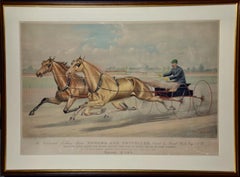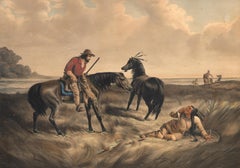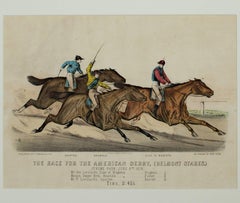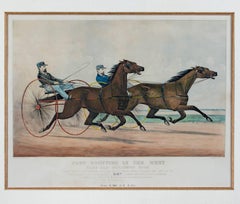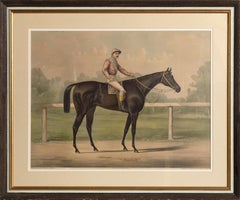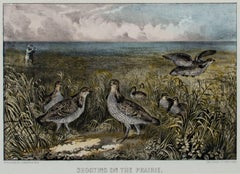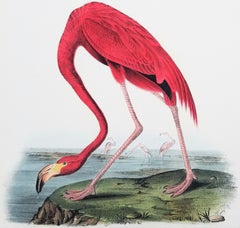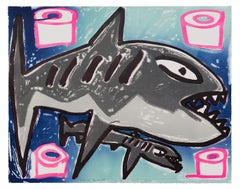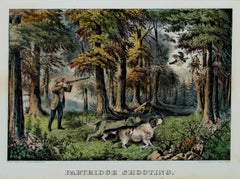Currier & Ives Animal Prints
American, 1834-1907
Currier and Ives was a prominent American printmaking establishment headquartered in New York operating from 1835 to 1907. Nathaniel Currier (1813-1888) started his business on his own, but later merged with James Merritt Ives (1824-1895), becoming "Currier and Ives" in 1857. They produced and sold hand-colored lithographs which could be produced relatively quickly and cheaply. They called themselves "the Grand Central Depot for Cheap and Popular Prints". The company published around 7,500 lithographs in its 72 years in business.to
1
2
2
1
2
Overall Width
to
Overall Height
to
20
195
161
113
94
7
7
6
5
3
2
2
2
2
1
1
1
7
4
7
Artist: Currier & Ives
19th C. Currier & Ives lithograph "Celebrated Trotting Team Edward & Swiveller"
By Currier & Ives
Located in Alamo, CA
This is an original 19th century Currier and Ives hand-colored lithograph entitled "The Celebrated Trotting Team Edward and Swiveller, Owned by Frank Work Esq. N.Y.: Winning their ma...
Category
1880s Currier & Ives Animal Prints
Materials
Lithograph
The Last War-Whoop!
By Currier & Ives
Located in Palm Desert, CA
"The Last War-Whoop!" is a lithograph by Currier & Ives. The framed size is 26 x 32.62 x 1.25 inches.
Provenance:
Private Collection
Category
Late 19th Century American Realist Currier & Ives Animal Prints
Materials
Lithograph
19th century color lithograph horses figures dynamic landscape
By Currier & Ives
Located in Milwaukee, WI
"The Race for the American Derby (Belmont Stakes)" is an original hand-colored lithograph published by Currier & Ives. It depicts three racehorses and their jockeys running in the Belmont Stakes. The caption for this lithograph says, "Spartan. Bramble. Duke of Magenta. Jerome Park, June 8th 1878. Mr. Geo. Lorillard's Duke of Magenta.....Hughes, 1....Messrs.Dwyer Bro's Bramble......Fisher, 2....Mr. P. Lorillard's Spartan.....Barrett, 3..... TIME 2:43 1/2."
12 7/8" x 16 7/8" art
21 7/8" x 25 7/8" frame
Currier & Ives produced their prints in a building at 33 Spruce Street where they occupied the third, fourth and fifth floors. The third floor was devoted to the hand operated printing presses that were built by Nat's cousin, Cyrus Currier, at his shop Cyrus Currier & Sons in Newark, NJ. The fourth floor found the artists, lithographers and the stone grinders...
Category
1870s Currier & Ives Animal Prints
Materials
Lithograph
19th century color lithograph horses chariot figures dynamic landscape
By Currier & Ives
Located in Milwaukee, WI
"Fast Trotting in the West (Milwaukee Race)" is an original hand-colored lithograph published by Currier & Ives. It depicts two horses pulling racing carts. The text below the picture reads "Fast Trotting in the West...Lucy and Goldsmith Maid...trotting their closely contested race over the cold spring course Milwaukee, Wis. Sept. 6th 1871...Where Goldsmith Maid won the 2nd heat in 2:17!! The fastest Mile heat in harness on record. Purse $4000 $2500 to 1st $1500 to 2nd horse____ 8 in. in harness. TIME 2:20 1/2 2:17 2:20"
16 3/4" x 26" image
22" x 27 3/4" paper
35 3/4" x 41 7/8" frame
Currier & Ives produced their prints in a building at 33 Spruce Street where they occupied the third, fourth and fifth floors. The third floor was devoted to the hand operated printing presses that were built by Nat's cousin, Cyrus Currier, at his shop Cyrus Currier & Sons in Newark, NJ. The fourth floor found the artists, lithographers and the stone grinders...
Category
1870s Currier & Ives Animal Prints
Materials
Lithograph
The Grand Racer Kingston by Spendthrift, Lithograph by Currier & Ives 1891
By Currier & Ives
Located in Long Island City, NY
Artist: Currier & Ives after Chaz Zellinsky after J. Cameron
Title: The Grand Racer Kingston by Spendthrift
Year: 1891
Medium: Hand-colored Lithograph
Image Size: 19 x 26 inches
Fram...
Category
Late 19th Century Victorian Currier & Ives Animal Prints
Materials
Lithograph
19th century color lithograph birds landscape nature grass sky water figure
By Currier & Ives
Located in Milwaukee, WI
"Shooting on the Prairie" is an original hand-colored lithograph by Currier & Ives. It depicts a hunter shooting at fowl in an open field.
8 1/2" x 12 1/2" art
20 1/4" x 23 3/4" frame
Nathaniel Currier was a tall introspective man with a melancholy nature. He could captivate people with his piercing stare or charm them with his sparkling blue eyes. Nathaniel was born in Roxbury, Massachusetts on March 27th, 1813, the second of four children. His parents, Nathaniel and Hannah Currier, were distant cousins who lived a humble yet spartan life. When Nathaniel was eight years old, tragedy struck. Nathaniel’s father unexpectedly passed away leaving Nathaniel and his eleven-year-old brother Lorenzo to provide for the family. In addition to their mother, Nathaniel and Lorenzo had to care for six-year-old sister Elizabeth and two-year-old brother Charles. Nathaniel worked a series of odd jobs to support the family, and at fifteen, he started what would become a life-long career when he apprenticed in the Boston lithography shop of William and John Pendleton.
A Bavarian gentleman named Alois Senefelder invented lithography just 30 years prior to young Nat Currier’s apprenticeship. While under the employ of the brothers Pendleton, Nat was taught the art of lithography by the firm’s chief printer, a French national named Dubois, who brought the lithography trade to America.
Lithography involves grinding a piece of limestone flat and smooth then drawing in mirror image on the stone with a special grease pencil. After the image is completed, the stone is etched with a solution of aqua fortis leaving the greased areas in slight relief. Water is then used to wet the stone and greased-ink is rolled onto the raised areas. Since grease and water do not mix, the greased-ink is repelled by the moisture on the stone and clings to the original grease pencil lines. The stone is then placed in a press and used as a printing block to impart black on white images to paper.
In 1833, now twenty-years old and an accomplished lithographer, Nat Currier left Boston and moved to Philadelphia to do contract work for M.E.D. Brown, a noted engraver and printer. With the promise of good money, Currier hired on to help Brown prepare lithographic stones of scientific images for the American Journal of Sciences and Arts. When Nat completed the contract work in 1834, he traveled to New York City to work once again for his mentor John Pendleton, who was now operating his own shop located at 137 Broadway. Soon after the reunion, Pendleton expressed an interest in returning to Boston and offered to sell his print shop to Currier. Young Nat did not have the financial resources to buy the shop, but being the resourceful type he found another local printer by the name of Stodart. Together they bought Pendleton’s business.
The firm ‘Currier & Stodart’ specialized in "job" printing. They produced many different types of printed items, most notably music manuscripts for local publishers. By 1835, Stodart was frustrated that the business was not making enough money and he ended the partnership, taking his investment with him. With little more than some lithographic stones, and a talent for his trade, twenty-two year old Nat Currier set up shop in a temporary office at 1 Wall Street in New York City. He named his new enterprise ‘N. Currier, Lithographer’
Nathaniel continued as a job printer and duplicated everything from music sheets to architectural plans. He experimented with portraits, disaster scenes and memorial prints, and any thing that he could sell to the public from tables in front of his shop. During 1835 he produced a disaster print Ruins of the Planter's Hotel, New Orleans, which fell at two O’clock on the Morning of the 15th of May 1835, burying 50 persons, 40 of whom Escaped with their Lives. The public had a thirst for newsworthy events, and newspapers of the day did not include pictures. By producing this print, Nat gave the public a new way to “see” the news. The print sold reasonably well, an important fact that was not lost on Currier.
Nat met and married Eliza Farnsworth in 1840. He also produced a print that same year titled Awful Conflagration of the Steamboat Lexington in Long Island Sound on Monday Evening, January 18, 1840, by which melancholy occurrence over One Hundred Persons Perished. This print sold out very quickly, and Currier was approached by an enterprising publication who contracted him to print a single sheet addition of their paper, the New York Sun. This single page paper is presumed to be the first illustrated newspaper ever published.
The success of the Lexington print launched his career nationally and put him in a position to finally lift his family up. In 1841, Nat and Eliza had their first child, a son they named Edward West Currier. That same year Nat hired his twenty-one year old brother Charles and taught him the lithography trade, he also hired his artistically inclined brother Lorenzo to travel out west and make sketches of the new frontier as material for future prints. Charles worked for the firm on and off over the years, and invented a new type of lithographic crayon which he patented and named the Crayola. Lorenzo continued selling sketches to Nat for the next few years.
In 1843, Nat and Eliza had a daughter, Eliza West Currier, but tragedy struck in early 1847 when their young daughter died from a prolonged illness. Nat and Eliza were grief stricken, and Eliza, driven by despair, gave up on life and passed away just four months after her daughter’s death.
The subject of Nat Currier’s artwork changed following the death of his wife and daughter, and he produced many memorial prints and sentimental prints during the late 1840s. The memorial prints generally depicted grief stricken families posed by gravestones (the stones were left blank so the purchasers could fill in the names of the dearly departed). The sentimental prints usually depicted idealized portraits of women and children, titled with popular Christian names of the day.
Late in 1847, Nat Currier married Lura Ormsbee, a friend of the family. Lura was a self-sufficient woman, and she immediately set out to help Nat raise six-year-old Edward and get their house in order. In 1849, Lura delivered a son, Walter Black Currier, but fate dealt them a blow when young Walter died one year later. While Nat and Lura were grieving the loss of their new son, word came from San Francisco that Nat’s brother Lorenzo had also passed away from a brief illness. Nat sank deeper into his natural quiet melancholy. Friends stopped by to console the couple, and Lura began to set an extra place at their table for these unexpected guests. She continued this tradition throughout their lives.
In 1852, Charles introduced a friend, James Merritt Ives, to Nat and suggested he hire him as a bookkeeper. Jim Ives was a native New Yorker born in 1824 and raised on the grounds of Bellevue Hospital where his father was employed as superintendent. Jim was a self-trained artist and professional bookkeeper. He was also a plump and jovial man, presenting the exact opposite image of his new boss.
Jim Ives met Charles Currier through Caroline Clark, the object of Jim’s affection. Caroline’s sister Elizabeth was married to Charles, and Caroline was a close friend of the Currier family. Jim eventually proposed marriage to Caroline and solicited an introduction to Nat Currier, through Charles, in hopes of securing a more stable income to support his future wife.
Ives quickly set out to improve and modernize his new employer’s bookkeeping methods. He reorganized the firm’s sizable inventory, and used his artistic skills to streamline the firm’s production methods. By 1857, Nathaniel had become so dependent on Jims’ skills and initiative that he offered him a full partnership in the firm and appointed him general manager. The two men chose the name ‘Currier & Ives’ for the new partnership, and became close friends.
Currier & Ives produced their prints in a building at 33 Spruce Street where they occupied the third, fourth and fifth floors. The third floor was devoted to the hand operated printing presses that were built by Nat's cousin, Cyrus Currier, at his shop Cyrus Currier & Sons in Newark, NJ. The fourth floor found the artists, lithographers and the stone grinders at work. The fifth floor housed the coloring department, and was one of the earliest production lines in the country. The colorists were generally immigrant girls, mostly German, who came to America with some formal artistic training. Each colorist was responsible for adding a single color to a print. As a colorist finished applying their color, the print was passed down the line to the next colorist to add their color. The colorists worked from a master print displayed above their table, which showed where the proper colors were to be placed. At the end of the table was a touch up artist who checked the prints for quality, touching-in areas that may have been missed as it passed down the line. During the Civil War, demand for prints became so great that coloring stencils were developed to speed up production.
Although most Currier & Ives prints were colored in house, some were sent out to contract artists. The rate Currier & Ives paid these artists for coloring work was one dollar per one hundred small folios (a penny a print) and one dollar per one dozen large folios. Currier & Ives also offered uncolored prints to dealers, with instructions (included on the price list) on how to 'prepare the prints for coloring.' In addition, schools could order uncolored prints from the firm’s catalogue to use in their painting classes.
Nathaniel Currier and James Merritt Ives attracted a wide circle of friends during their years in business. Some of their more famous acquaintances included Horace Greeley, Phineas T. Barnum, and the outspoken abolitionists Rev. Henry Ward, and John Greenleaf Whittier (the latter being a cousin of Mr. Currier).
Nat Currier and Jim Ives described their business as "Publishers of Cheap and Popular Pictures" and produced many categories of prints. These included Disaster Scenes, Sentimental Images, Sports, Humor, Hunting Scenes, Politics, Religion, City and Rural Scenes, Trains, Ships, Fire Fighters, Famous Race Horses, Historical Portraits, and just about any other topic that satisfied the general public's taste. In all, the firm produced in excess of 7500 different titles, totaling over one million prints produced from 1835 to 1907.
Nat Currier retired in 1880, and signed over his share of the firm to his son Edward. Nat died eight years later at his summer home 'Lion’s Gate' in Amesbury, Massachusetts. Jim Ives remained active in the firm until his death in 1895, when his share of the firm passed to his eldest son, Chauncey.
In 1902, faced will failing health from the ravages of Tuberculosis, Edward Currier sold his share of the firm to Chauncey Ives...
Category
1870s Other Art Style Currier & Ives Animal Prints
Materials
Lithograph
19th century color lithograph dogs bird nature grass pastoral animals
By Currier & Ives
Located in Milwaukee, WI
"Flushing a Woodcock" is an original hand-colored lithograph published by Currier & Ives. It depicts two dogs at the edge of a pond going after a bird that has just flown into the air.
8" x 12 1/2" art
18 1/2" x 22 1/4" frame
Currier & Ives produced their prints in a building at 33 Spruce Street where they occupied the third, fourth and fifth floors. The third floor was devoted to the hand operated printing presses that were built by Nat's cousin, Cyrus Currier, at his shop Cyrus Currier & Sons in Newark, NJ. The fourth floor found the artists, lithographers and the stone grinders...
Category
1850s Currier & Ives Animal Prints
Materials
Lithograph
Related Items
American Flamingo /// John James Audubon Natural History Ornithology Bird Litho
By John James Audubon
Located in Saint Augustine, FL
Artist: John James Audubon (American, 1785-1851)
Title: "American Flamingo" (Plate 375, No. 75)
Portfolio: The Birds of America, First Royal Octavo E...
Category
1840s Victorian Currier & Ives Animal Prints
Materials
Watercolor, Lithograph
Swimmers
By Katherine Bernhardt
Located in London, GB
Edition of 175. 6 Colour lithograph on Somerset Velvet White 300gsm. Signed, titled and dated by the artist.
Category
2010s Currier & Ives Animal Prints
Materials
Lithograph
Whooping Crane /// John James Audubon Ornithology Natural History Wading Birds
By John James Audubon
Located in Saint Augustine, FL
Artist: John James Audubon (American, 1785-1851)
Title: "Whooping Crane" (Plate 313, No. 63)
Portfolio: The Birds of America, First Royal Octavo Edition
Year: 1840-1844
Medium: Origi...
Category
1840s Victorian Currier & Ives Animal Prints
Materials
Watercolor, Lithograph
Bernard Buffet - Homage to Dufy - Lithograph
By Bernard Buffet
Located in Collonge Bellerive, Geneve, CH
(after) Bernard Buffet
Lithograph after a watercolor, published in the book "Lettre à mon peintre Raoul Dufy." Paris, Librairie Académique Perrin, 1965.
Printed signature
Dimension...
Category
1940s Fauvist Currier & Ives Animal Prints
Materials
Lithograph
$1,414
H 11.82 in W 9.45 in D 0.04 in
Vintage MOMA Francesco Clemente Museum of Modern Art 1986 dream myth poster
By Francesco Clemente
Located in New York, NY
This three-part work spanning 10 feet was printed from the plates of Francesco Clemente’s mythological landscape Untitled A on the occasion of the 1986 MoMA, New York show of Clement...
Category
1980s Surrealist Currier & Ives Animal Prints
Materials
Lithograph, Offset
Haystack
By Thomas Hart Benton
Located in London, GB
A fine impression of this very popular image with full margins (smaller on top and bottom) published by Associated American Artists.
Category
1930s American Modern Currier & Ives Animal Prints
Materials
Lithograph
Romare Bearden, Dreams of Exile (Green Snake), 1971, by African-American, signed
By Romare Bearden
Located in New York, NY
A North Carolina native, the African-American Romare Bearden spent most of his career in New York City. For several decades he was a social worker in Harlem. But of course he traveled widely, read and studied with great care, and created a phenomenal body of work.
This 1971 lithograph is a good example of his oeuvre -- far reaching though it may be. It speaks to his skill and knowledge of contemporary printmaking while featuring a complex subject representative of his interests.
A lush jungles is packed with flora and fauna. 'Green Snake' is part of the title and there is a particularly winsome reptile showing up so well on the sand-colored border between the dense forest and the aquamarine water. There are of course many other land and sea animals showing themselves -- even a curious ginger cat...
Category
1970s Contemporary Currier & Ives Animal Prints
Materials
Lithograph
Romare BeardenRomare Bearden, Dreams of Exile (Green Snake), 1971, by African-American, signed, 1971
$5,750
H 21.5 in W 16.5 in
Nebraska Evening
By Thomas Hart Benton
Located in London, GB
A fine impression with good margins published by Associated American Artists.
Category
1940s American Modern Currier & Ives Animal Prints
Materials
Lithograph
THE BANNISTER
By Will Barnet
Located in Aventura, FL
Lithograph on arches paper. Hand signed, dated titled and numbered in pencil by the artist. From the deluxe edition of 125. Image size 32 x 25 inches. Sheet size 36 x 26.5 inches. ...
Category
1980s Contemporary Currier & Ives Animal Prints
Materials
Paper, Lithograph
Original "The Ships Are Coming" vintage American poster with an Eagle.
By James Henry Daugherty
Located in Spokane, WA
Original: THE SHIPS ARE COMING vintage poster. Artist: James H. Daugherty (1889-1974)
Publisher: U.S. Shipping Board, Emergency Fleet Corporation, Publication Section, Philadelphia, 1917.
Poster showing a giant eagle...
Category
1910s American Modern Currier & Ives Animal Prints
Materials
Lithograph
James Henry DaughertyOriginal "The Ships Are Coming" vintage American poster with an Eagle., 1917-18
$1,663 Sale Price
20% Off
H 30 in W 20 in D 0.05 in
Origiinal FRANCE, Paese dei Casstelli, vintage French travel poster on linen
By Jean Picart Le Doux
Located in Spokane, WA
Original 1950 “France, Paese dei Castelli” Vintage Poster Artist Jean Picart Le Doux Linen-Backed French Castles Travel Art Rare Mid-Century Collectible
Add a touch of French el...
Category
1950s American Modern Currier & Ives Animal Prints
Materials
Lithograph
$975
H 39.5 in W 24.5 in D 0.3 in
Long-billed Curlew (City of Charleston) /// Ornithology John James Audubon Bird
By John James Audubon
Located in Saint Augustine, FL
Artist: John James Audubon (American, 1785-1851)
Title: "Long-billed Curlew (City of Charleston)" (Plate 355, No. 71)
Portfolio: The Birds of America, First Royal Octavo Edition...
Category
1840s Victorian Currier & Ives Animal Prints
Materials
Watercolor, Lithograph
Previously Available Items
"Partridge Shooting, " Original Color Lithograph Landscape by Currier & Ives
By Currier & Ives
Located in Milwaukee, WI
"Partridge Shooting" is an original color lithograph by Currier & Ives. It depicts a hunter shooting a partridge and his dogs rushing to retrieve it. The figure and animals are in a dense forest.
11" x 14" art
19 3/4" x 23" frame
Nathaniel Currier was a tall introspective man with a melancholy nature. He could captivate people with his piercing stare or charm them with his sparkling blue eyes. Nathaniel was born in Roxbury, Massachusetts on March 27th, 1813, the second of four children. His parents, Nathaniel and Hannah Currier, were distant cousins who lived a humble yet spartan life. When Nathaniel was eight years old, tragedy struck. Nathaniel’s father unexpectedly passed away leaving Nathaniel and his eleven-year-old brother Lorenzo to provide for the family. In addition to their mother, Nathaniel and Lorenzo had to care for six-year-old sister Elizabeth and two-year-old brother Charles. Nathaniel worked a series of odd jobs to support the family, and at fifteen, he started what would become a life-long career when he apprenticed in the Boston lithography shop of William and John Pendleton.
A Bavarian gentleman named Alois Senefelder invented lithography just 30 years prior to young Nat Currier’s apprenticeship. While under the employ of the brothers Pendleton, Nat was taught the art of lithography by the firm’s chief printer, a French national named Dubois, who brought the lithography trade to America.
Lithography involves grinding a piece of limestone flat and smooth then drawing in mirror image on the stone with a special grease pencil. After the image is completed, the stone is etched with a solution of aqua fortis leaving the greased areas in slight relief. Water is then used to wet the stone and greased-ink is rolled onto the raised areas. Since grease and water do not mix, the greased-ink is repelled by the moisture on the stone and clings to the original grease pencil lines. The stone is then placed in a press and used as a printing block to impart black on white images to paper.
In 1833, now twenty-years old and an accomplished lithographer, Nat Currier left Boston and moved to Philadelphia to do contract work for M.E.D. Brown, a noted engraver and printer. With the promise of good money, Currier hired on to help Brown prepare lithographic stones of scientific images for the American Journal of Sciences and Arts. When Nat completed the contract work in 1834, he traveled to New York City to work once again for his mentor John Pendleton, who was now operating his own shop located at 137 Broadway. Soon after the reunion, Pendleton expressed an interest in returning to Boston and offered to sell his print shop to Currier. Young Nat did not have the financial resources to buy the shop, but being the resourceful type he found another local printer by the name of Stodart. Together they bought Pendleton’s business.
The firm ‘Currier & Stodart’ specialized in "job" printing. They produced many different types of printed items, most notably music manuscripts for local publishers. By 1835, Stodart was frustrated that the business was not making enough money and he ended the partnership, taking his investment with him. With little more than some lithographic stones, and a talent for his trade, twenty-two year old Nat Currier set up shop in a temporary office at 1 Wall Street in New York City. He named his new enterprise ‘N. Currier, Lithographer’
Nathaniel continued as a job printer and duplicated everything from music sheets to architectural plans. He experimented with portraits, disaster scenes and memorial prints, and any thing that he could sell to the public from tables in front of his shop. During 1835 he produced a disaster print Ruins of the Planter's Hotel, New Orleans, which fell at two O’clock on the Morning of the 15th of May 1835, burying 50 persons, 40 of whom Escaped with their Lives. The public had a thirst for newsworthy events, and newspapers of the day did not include pictures. By producing this print, Nat gave the public a new way to “see” the news. The print sold reasonably well, an important fact that was not lost on Currier.
Nat met and married Eliza Farnsworth in 1840. He also produced a print that same year titled Awful Conflagration of the Steamboat Lexington in Long Island Sound on Monday Evening, January 18, 1840, by which melancholy occurrence over One Hundred Persons Perished. This print sold out very quickly, and Currier was approached by an enterprising publication who contracted him to print a single sheet addition of their paper, the New York Sun. This single page paper is presumed to be the first illustrated newspaper ever published.
The success of the Lexington print launched his career nationally and put him in a position to finally lift his family up. In 1841, Nat and Eliza had their first child, a son they named Edward West Currier. That same year Nat hired his twenty-one year old brother Charles and taught him the lithography trade, he also hired his artistically inclined brother Lorenzo to travel out west and make sketches of the new frontier as material for future prints. Charles worked for the firm on and off over the years, and invented a new type of lithographic crayon which he patented and named the Crayola. Lorenzo continued selling sketches to Nat for the next few years.
In 1843, Nat and Eliza had a daughter, Eliza West Currier, but tragedy struck in early 1847 when their young daughter died from a prolonged illness. Nat and Eliza were grief stricken, and Eliza, driven by despair, gave up on life and passed away just four months after her daughter’s death.
The subject of Nat Currier’s artwork changed following the death of his wife and daughter, and he produced many memorial prints and sentimental prints during the late 1840s. The memorial prints generally depicted grief stricken families posed by gravestones (the stones were left blank so the purchasers could fill in the names of the dearly departed). The sentimental prints usually depicted idealized portraits of women and children, titled with popular Christian names of the day.
Late in 1847, Nat Currier married Lura Ormsbee, a friend of the family. Lura was a self-sufficient woman, and she immediately set out to help Nat raise six-year-old Edward and get their house in order. In 1849, Lura delivered a son, Walter Black Currier, but fate dealt them a blow when young Walter died one year later. While Nat and Lura were grieving the loss of their new son, word came from San Francisco that Nat’s brother Lorenzo had also passed away from a brief illness. Nat sank deeper into his natural quiet melancholy. Friends stopped by to console the couple, and Lura began to set an extra place at their table for these unexpected guests. She continued this tradition throughout their lives.
In 1852, Charles introduced a friend, James Merritt Ives, to Nat and suggested he hire him as a bookkeeper. Jim Ives was a native New Yorker born in 1824 and raised on the grounds of Bellevue Hospital where his father was employed as superintendent. Jim was a self-trained artist and professional bookkeeper. He was also a plump and jovial man, presenting the exact opposite image of his new boss.
Jim Ives met Charles Currier through Caroline Clark, the object of Jim’s affection. Caroline’s sister Elizabeth was married to Charles, and Caroline was a close friend of the Currier family. Jim eventually proposed marriage to Caroline and solicited an introduction to Nat Currier, through Charles, in hopes of securing a more stable income to support his future wife.
Ives quickly set out to improve and modernize his new employer’s bookkeeping methods. He reorganized the firm’s sizable inventory, and used his artistic skills to streamline the firm’s production methods. By 1857, Nathaniel had become so dependent on Jims’ skills and initiative that he offered him a full partnership in the firm and appointed him general manager. The two men chose the name ‘Currier & Ives’ for the new partnership, and became close friends.
Currier & Ives produced their prints in a building at 33 Spruce Street where they occupied the third, fourth and fifth floors. The third floor was devoted to the hand operated printing presses that were built by Nat's cousin, Cyrus Currier, at his shop Cyrus Currier & Sons in Newark, NJ. The fourth floor found the artists, lithographers and the stone grinders at work. The fifth floor housed the coloring department, and was one of the earliest production lines in the country. The colorists were generally immigrant girls, mostly German, who came to America with some formal artistic training. Each colorist was responsible for adding a single color to a print. As a colorist finished applying their color, the print was passed down the line to the next colorist to add their color. The colorists worked from a master print displayed above their table, which showed where the proper colors were to be placed. At the end of the table was a touch up artist who checked the prints for quality, touching-in areas that may have been missed as it passed down the line. During the Civil War, demand for prints became so great that coloring stencils were developed to speed up production.
Although most Currier & Ives prints were colored in house, some were sent out to contract artists. The rate Currier & Ives paid these artists for coloring work was one dollar per one hundred small folios (a penny a print) and one dollar per one dozen large folios. Currier & Ives also offered uncolored prints to dealers, with instructions (included on the price list) on how to 'prepare the prints for coloring.' In addition, schools could order uncolored prints from the firm’s catalogue to use in their painting classes.
Nathaniel Currier and James Merritt Ives attracted a wide circle of friends during their years in business. Some of their more famous acquaintances included Horace Greeley, Phineas T. Barnum, and the outspoken abolitionists Rev. Henry Ward, and John Greenleaf Whittier (the latter being a cousin of Mr. Currier).
Nat Currier and Jim Ives described their business as "Publishers of Cheap and Popular Pictures" and produced many categories of prints. These included Disaster Scenes, Sentimental Images, Sports, Humor, Hunting Scenes, Politics, Religion, City and Rural Scenes, Trains, Ships, Fire Fighters, Famous Race Horses, Historical Portraits, and just about any other topic that satisfied the general public's taste. In all, the firm produced in excess of 7500 different titles, totaling over one million prints produced from 1835 to 1907.
Nat Currier retired in 1880, and signed over his share of the firm to his son Edward. Nat died eight years later at his summer home 'Lion’s Gate' in Amesbury, Massachusetts. Jim Ives remained active in the firm until his death in 1895, when his share of the firm passed to his eldest son, Chauncey.
In 1902, faced will failing health from the ravages of Tuberculosis, Edward Currier sold his share of the firm to Chauncey Ives...
Category
1870s Other Art Style Currier & Ives Animal Prints
Materials
Lithograph
"Autumn on Lake George (Deer), " an Original Lithograph by Currier & Ives
By Currier & Ives
Located in Milwaukee, WI
"Autumn on Lake George (Deer)" is an original hand-colored lithograph published by Currier & Ives. It depicts multiple deer in an idyllic landscape with trees and a lake.
8" x 12 1/2" art
17 5/8" x 22" frame
Currier & Ives produced their prints in a building at 33 Spruce Street where they occupied the third, fourth and fifth floors. The third floor was devoted to the hand operated printing presses that were built by Nat's cousin, Cyrus Currier, at his shop Cyrus Currier & Sons in Newark, NJ. The fourth floor found the artists, lithographers and the stone grinders...
Category
1850s Currier & Ives Animal Prints
Materials
Lithograph
Currier & Ives animal prints for sale on 1stDibs.
Find a wide variety of authentic Currier & Ives animal prints available for sale on 1stDibs. You can also browse by medium to find art by Currier & Ives in lithograph and more. Not every interior allows for large Currier & Ives animal prints, so small editions measuring 23 inches across are available. Customers who are interested in this artist might also find the work of Louis Prang, and Lionel Edwards. Currier & Ives animal prints prices can differ depending upon medium, time period and other attributes. On 1stDibs, the price for these items starts at $1,900 and tops out at $22,500, while the average work can sell for $5,420.
Artists Similar to Currier & Ives
Questions About Currier & Ives Animal Prints
- How old is Currier and Ives?1 Answer1stDibs ExpertFebruary 13, 2024Currier and Ives is more than 175 years old. The prominent American printmaking business, headquartered in New York, operated from 1835 to 1907. Nathaniel Currier started his business on his own but later merged with James Merritt Ives, becoming "Currier and Ives" in 1857. They produced and sold hand-colored lithographs, which could be produced relatively quickly and cheaply. Explore a collection of Currier and Ives prints on 1stDibs.
- 1stDibs ExpertAugust 29, 2024To tell if it’s an original Currier & Ives print, get a magnifying glass and study the image up close. If you notice a regular pattern of dots, the piece is likely a reproduction, as the printing techniques used to make originals usually resulted in irregular, non-symmetrical dashes and dots. Next, look at your piece from the side with the naked eye. If the paper appears perfectly smooth and uniform, the print is unlikely to be an original Currier & Ives, which will typically show off variations in luster and texture. When in doubt, have a certified appraiser or knowledgeable art dealer help you with the authentication process. On 1stDibs, shop a selection of Currier & Ives prints.
- 1stDibs ExpertOctober 30, 2024Yes, some Currier and Ives pieces are worth something. The company published around 7,500 lithographs in its 72 years in business, and some, such as The American National Game of Base Ball, have sold for more than $75,000 in the past. Generally, the historical significance, image quality, age and condition of the publisher's prints will determine their worth. A certified appraiser or experienced art dealer can evaluate any prints you own using these criteria and give you an idea of how much they may be worth. Find an assortment of Currier & Ives prints on 1stDibs.
- 1stDibs ExpertSeptember 9, 2024Yes, some Currier and Ives dishes are worth something. Limited edition pieces are most likely to be valuable, and sets often fetch higher prices than individual pieces. Generally, the age, style, type and condition will all play a role in determining the value. A certified appraiser or knowledgeable antique dealer can help you with the valuation process. Find a selection of Currier and Ives art and tableware on 1stDibs.
- 1stDibs ExpertMarch 22, 2022To tell if your Currier and Ives print is real, make sure that the print has the proper information. A genuine print will show the title and the publisher name as either "N. Currier" or "Currier & Ives". You may also find a publication address, a copyright notice and a catalog number on some pieces. You'll find a selection of expertly vetted Currier and Ives print prints on 1stDibs.
- 1stDibs ExpertSeptember 9, 2024How much original Currier & Ives prints are worth depends on their age, image quality, overall condition and other factors. In 2004, a hand-colored version of the 1866 lithograph The American National Game of Base Ball sold for $76,375. The Currier & Ives company published around 7,500 lithographs in its 72 years in business. Pieces that commemorate historical events are often the most highly sought-after among collectors. If you own a Currier & Ives lithograph, a certified appraiser or knowledgeable art dealer can aid you with the valuation process. On 1stDibs, shop a range of Currier & Ives prints.
